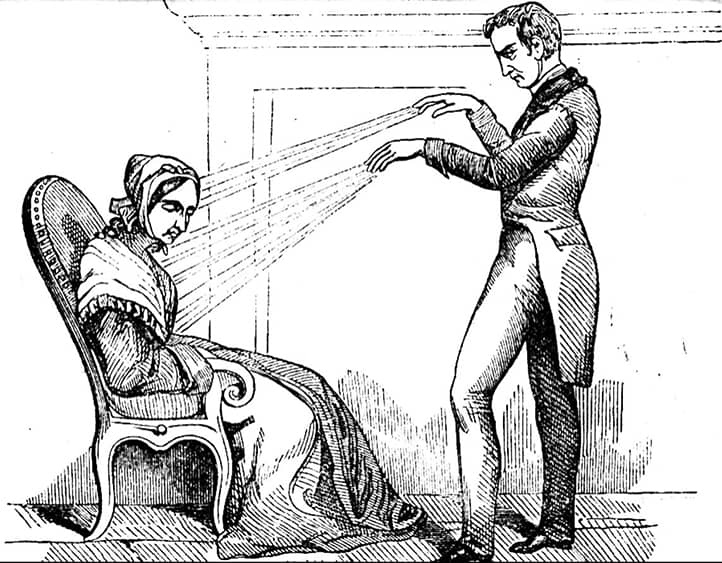Mesmerism is a term that originated in the 18th century when Austrian physician Franz Anton Mesmer introduced the concept of “animal magnetism.” Mesmer claimed this invisible energy flow, similar to magnetic fields, could influence a person’s physical and mental state. He believed that proper manipulation of this energy could cure illnesses and restore harmony in the body.
This idea was revolutionary for its time, although it sparked significant controversy in the scientific community. Over time, mesmerism became the foundation for the development of hypnosis, which later gained scientific validation through psychological and neurological research.
The historical context of mesmerism reveals an intriguing evolution of ideas. From Mesmer’s initial experiments, often marked by theatricality, to serious studies of hypnosis’s effects on the psyche, this concept has traveled a long journey.
While critics dismissed mesmerism as fraud, others saw it as a foundation for understanding the subconscious and mechanisms of influence on it. Hypnosis, now recognized as a legitimate part of scientific psychotherapy, can be considered a descendant of mesmerism, although it has shed its magical terminology and gained scientific backing.
Despite being over two centuries old, the ideas of mesmerism continue to generate interest today. This is largely due to the growing popularity of methods targeting the subconscious, such as hypnotherapy, cognitive-behavioral therapy, and various relaxation techniques.
In the modern world, people increasingly seek ways to improve their emotional and psychological well-being, and methods that tap into the body’s internal reserves are particularly appealing. However, many still confuse mesmerism with pseudoscientific practices that promise “miraculous” healing without any evidence base.
Therefore, it is essential to distinguish between scientific approaches to studying subconscious influence and practices that resemble occultism. In modern psychotherapy, mesmerism is no longer associated with literal magnetism, but its legacy remains significant for understanding psychological techniques of influence. Examining this topic not only traces the evolution of approaches to working with the psyche but also separates genuine psychotherapy tools from those lacking scientific grounding.

Mesmerism: Myths
Due to its unusual nature, mesmerism has become the subject of much speculation, exaggeration, and myth. Although the concept has lost its original form, many people still associate it with magic, universal healing, or even view modern hypnosis as a direct continuation of Mesmer’s methods.
Debunking these myths is essential not only for a better understanding of psychology’s history but also for fostering critical thinking about contemporary practices that misuse the term “mesmerism” in a pseudoscientific context. While psychotherapy today relies on scientific approaches, parts of society still succumb to popular myths that romanticize Mesmer’s ideas.
Myth 1: Mesmerism is magic
The most common myth perceives mesmerism as a form of magic or occult art. This notion partly stems from how Franz Mesmer presented his methods. His sessions often featured a theatrical atmosphere: dim lighting, music, dramatic gestures, and an air of mystery. Mesmer even used metal rods, which he believed transmitted magnetic energy.
However, Mesmer never described his methods as magical. He believed “animal magnetism” was a natural phenomenon that could be scientifically explained. At the time, science lacked the tools to either refute or confirm his hypotheses. Today, it is clear that “animal magnetism” does not exist as Mesmer described. Its effectiveness can be attributed to psychological mechanisms like suggestion, the placebo effect and the impact of atmosphere on patients’ psyches.
Myth 2: Mesmerism can cure all diseases
During Mesmer’s lifetime, his methods were advertised as a universal cure. He claimed “animal magnetism” could treat nearly any illness—from headaches to mental disorders. This promise of quick and universal healing attracted attention but also angered medical professionals.
Many patients reported improvements after Mesmer’s sessions, but modern science attributes this to the placebo effect. Mesmerism did not work due to magnetic energy but rather through strong emotional and psychological influence. Patients often experienced relief because of their belief in the method and the relaxation and stress reduction provided during sessions.
Today, it is known that no single method, including mesmerism, can be a universal cure. The effectiveness of any therapeutic or medical approach depends on the specific illness, the patient’s condition, and the use of evidence-based methods.
Myth 3: Modern hypnosis is a direct continuation of mesmerism
Another common myth is that modern hypnosis directly descends from mesmerism. While Mesmer was among the first to explore the trance state, modern hypnosis differs significantly from his practices.
After Mesmer’s death, his ideas faced serious criticism, but some aspects of his methods were preserved and developed. For example, James Braid, who coined the term “hypnosis,” rejected the concept of magnetism and focused on the psychological mechanisms underlying the trance state. Hypnosis in modern psychotherapy is based on scientific principles, studied within psychology and neuroscience, and its effectiveness is supported by empirical research rather than ideas of “magnetic energy.”
Debunking Myths Through Modern Scientific Research
Modern science has shown that many aspects of mesmerism are either mythologized or misunderstood. Mesmer’s methods were not based on magical properties or universal energy but on psychological influence. This is supported by numerous studies on the placebo effect, hypnotherapy, and the role of patient belief in treatment success.
Today, mesmerism holds a symbolic place in psychology’s history. It serves as a reminder of the importance of developing a scientific approach and critical thinking to distinguish genuine therapeutic tools from myths and pseudoscience.

The Reality of Mesmerism in Psychotherapy
Mesmerism, despite its controversial reputation, has left a significant mark on psychology and psychotherapy. Although Franz Anton Mesmer’s ideas about “animal magnetism” have been debunked, many of his methods and approaches laid the groundwork for modern techniques aimed at working with the subconscious. A central role in this was played by the state of trance, which Mesmer described as a tool for influencing the psyche. Today, methods related to hypnosis, relaxation, and suggestion are actively used in the treatment of psychosomatic and mental disorders. However, these methods are now supported by scientific evidence and are far removed from the theatrical practices of the 18th century.
The reality of mesmerism in psychotherapy manifests through parallels between Mesmer’s ideas and contemporary scientific approaches. While “animal magnetism” is recognized as a scientific fallacy, the mechanisms of subconscious influence described by Mesmer have proven relevant. The effects of suggestion, the creation of a safe space for the client, and emotional interaction have become fundamental elements of modern psychotherapy.
The contributions of mesmerism are also evident in the history of neurology and psychiatry. Ideas about the possibility of altering mental states by influencing the nervous system stimulated research that eventually led to understanding the nature of hypnosis, the role of the subconscious, and the connection between emotional and physical health.
The Use of Hypnosis Techniques in Treating Anxiety Disorders, Depression and Addictions
One of mesmerism’s most significant practical achievements is the development of hypnosis, now employed as an evidence-based method in psychotherapy. Modern hypnosis is effectively used to treat depression, anxiety disorders, post-traumatic stress disorder (PTSD) and various addictions.
For example, in the case of anxiety disorders, hypnosis helps patients reduce stress levels and manage anxious thoughts through deep relaxation and the suggestion of positive attitudes. During a trance state, the therapist can “reprogram” the patient’s negative reactions to triggers, replacing them with more adaptive behavioral patterns.
In treating depression, hypnosis allows patients to access profound emotional experiences that are difficult to process in a waking state. This process can uncover hidden causes of depression and address traumatic memories.
Hypnotherapy is also effective in overcoming addictions, including alcohol, drug, or food dependencies. During sessions, the therapist works with the patient’s subconscious beliefs that fuel the addiction, forming new behavioral patterns that help prevent relapse.
Parallels Between Mesmer’s Ideas and Modern Psychotherapeutic Methods
Many of Mesmer’s ideas, even without their original “magnetic” justification, resonate with contemporary psychotherapeutic methods. For instance, the concept of suggestion, widely applied by Mesmer, remains a key tool in hypnotherapy. In modern practice, suggestion is used to instill positive beliefs, reduce fears, and correct behavior.
Relaxation, another significant element of Mesmer’s sessions, was once attributed to the influence of magnetism. Today, it is understood as a result of creating a comfortable atmosphere, fostering a sense of safety and trust. These elements are widely used in cognitive-behavioral therapy, mindfulness techniques, and meditation.
The focus on subconscious influence, which Mesmer regarded as a cornerstone of his method, is now implemented through hypnosis, psychoanalytic techniques, and trauma-focused methods. The idea that emotions and experiences hidden in the subconscious can shape behavior has become the foundation of many modern psychotherapeutic approaches.
The Contribution of Mesmerism to the Development of Psychotherapy and Neurology
Mesmerism played a significant role in establishing psychotherapy as a distinct field. Mesmer’s ideas stimulated early research into the effects of mental states on the body. While the concept of “animal magnetism” was rejected, it drew attention to the phenomenon of trance, which became the basis for more serious scientific exploration.
In the 19th century, studies on hypnosis by James Braid, Jean-Martin Charcot, and Sigmund Freud were inspired by experiments rooted in mesmerism. These studies laid the foundation for understanding psychosomatic disorders and the role of the subconscious in shaping mental states.
The contributions of mesmerism are also evident in neurology. The idea that mental states could affect physical health spurred the development of neuropsychology, which investigates the connection between the brain, emotions, and behavior.
Thus, while mesmerism is not recognized as a scientific concept, it has contributed to the discovery of new horizons in psychology, psychotherapy, and neurology. It served as a catalyst for numerous breakthroughs that are now crucial to the science of the psyche.

Modern Research and Practices
Mesmerism has left a significant mark on contemporary psychotherapy. Its ideas laid the foundation for the development of hypnosis techniques, the study of the subconscious, and the exploration of the placebo effect. In modern practice, many methods once associated with mesmerism have found scientific validation and are effectively used to help people with mental and psychosomatic disorders.
Today, hypnotherapy is a recognized treatment method widely applied in clinical psychology. Research indicates that hypnosis can be effective in treating anxiety disorders, depression, chronic pain, addictions, and even in improving cognitive performance. At the same time, mesmerism remains an important historical aspect studied in psychotherapy education to better understand the evolution of psychological science.
Special attention is given to the placebo effect, which is often a key factor in the success of mesmerist techniques. Studying this phenomenon helps to better understand the mechanisms of suggestion, trust, and expectation, opening new possibilities for improving psychotherapeutic methods.
The Place of Mesmerism in Psychotherapy Education and Research
Mesmerism holds a significant place in the history of psychotherapy and is a mandatory part of the curriculum for psychology and psychiatry students. Studying the theory and practice of mesmerism allows future professionals to understand how science developed through experiments, mistakes, and discoveries.
For instance, courses on the history of psychology highlight how mesmerism led to the first studies of trance, which later evolved into the exploration of hypnosis. Students analyze how perceptions of suggestion changed, from magnetic fields to understanding psychological mechanisms.
Additionally, mesmerism is often discussed in the context of pseudoscience. It serves as an example of how unscientific theories can gain popularity through a charismatic leader or people’s belief in “miraculous” healing. Analyzing these aspects helps develop critical thinking in future psychologists.
The Role of the Placebo Effect in the Success of Mesmerist Techniques
One of the most intriguing aspects of mesmerism is its close connection with the placebo effect. Mesmerist sessions often brought noticeable relief to patients, even though their actions lacked a real physical basis. Modern science explains this by emphasizing that the effectiveness of treatment largely depended on the patients’ belief in the method and Mesmer’s charisma.
The placebo effect operates on the principle of interaction between expectations and neuropsychological mechanisms. When a person believes a method will help, the brain begins to release endorphins and other chemicals that improve well-being. In mesmerist sessions, the atmosphere played a crucial role: special decorations, music, and magnetic gestures created a sense of experiencing a truly unique event.
Today, the study of the placebo effect helps to better understand how psychological factors influence treatment efficacy. For example, clinical trials consider not only the properties of medications but also patients’ expectations. In psychotherapy, this effect is used to build trust between the therapist and the client, enhancing the effectiveness of suggestion and relaxation methods.
Modern research and practices confirm that while mesmerism as a theory is no longer relevant, its legacy is evident in areas such as hypnotherapy, the study of the placebo effect, and psychotherapy education. This underscores the importance of historical context in understanding the evolution of psychology and its methods.

Ethical Aspects of Using Mesmerism
Ethical issues related to methods derived from mesmerism remain relevant today. Both in the 18th century and now, any intervention into a person’s consciousness sparks debates about the fine line between treatment and manipulation. The use of hypnosis, suggestion, or even relaxation techniques always requires strict adherence to ethical standards, as these practices directly influence the psyche and sometimes subconscious mechanisms.
The main ethical concern lies in the dual potential of these methods—to benefit or harm the individual. Skilled application of hypnosis or suggestion can alleviate psychological suffering, cure phobias, or help overcome addictions. However, misuse of these methods carries risks of manipulating consciousness, imposing foreign ideas, or exploiting the patient’s vulnerable state. This demands not only high professionalism from therapists but also strict observance of ethical principles when working with clients.
Today, psychological and psychotherapeutic organizations place particular emphasis on creating ethical codes that regulate the use of hypnosis and similar techniques. These codes outline permissible boundaries of influence, emphasize the importance of obtaining voluntary consent from clients, and stress the need to protect their autonomy. They also prioritize transparency in the therapeutic process to eliminate any suspicion of manipulative intentions by the therapist.
Influence on Consciousness: The Boundary Between Treatment and Manipulation
One of the key ethical dilemmas surrounding methods derived from mesmerism is the question of influencing consciousness. Hypnosis and suggestion techniques provide access to the subconscious, impacting profound aspects of personality. This is both their strength and their risk.
The primary ethical distinction between treatment and manipulation lies in the intent and methods of using these techniques. For instance, in psychotherapy, hypnosis is employed to aid the patient by alleviating fears, overcoming psychological trauma, or correcting destructive behavioral patterns. However, if the same techniques are used to coerce someone into decisions contrary to their will, it constitutes manipulation.
Another critical aspect is the trust between therapist and patient. A patient who trusts the therapist is typically more susceptible to suggestion, which necessitates the therapist’s utmost honesty and transparency. For example, using hypnosis for personal gain or influencing the patient in ways that do not align with their interests is unacceptable.
Additionally, potential side effects of influencing consciousness must be considered. Improperly conducted hypnosis can cause psychological discomfort, heightened anxiety, or even a traumatic experience for the patient. Thus, any intervention should be performed only after a thorough assessment of the client’s condition and with their informed consent.
Ethical Challenges of Using Hypnosis and Suggestion
The application of hypnosis and suggestion requires therapists to possess not only high professional qualifications but also an understanding of ethical responsibility. One of the primary issues is obtaining the client’s informed consent. Before starting a session, the therapist must explain how hypnosis works, its stages, and what is expected from the patient. The client has the right to decline or halt the process at any time if they feel uncomfortable.
Another challenge is avoiding abuse of power. During hypnosis, the therapist is in a position of authority, with the patient fully trusting their words and actions. Therefore, it is crucial that the specialist does not exploit this state for personal benefit or manipulative purposes. For instance, there have been cases where hypnosis was used to impose political or religious views, which constitutes a gross violation of ethical norms.
There is also the issue of using suggestion for marketing and commercial purposes. In some cases, techniques resembling mesmerism are employed to influence consumers, persuading them to purchase a product or service. This raises serious ethical concerns, as consumers may not always be aware that psychological pressure is being exerted on them.
Ethical challenges also arise in medical practice. For example, if a patient under hypnosis is made to believe that a medical procedure is entirely safe without being fully informed of the risks, it can lead to serious consequences.
The use of methods related to mesmerism always requires adherence to ethical standards. This ensures that these methods’ potential to help people is harnessed without infringing on their rights or freedoms.

Conclusions
Mesmerism, which once captivated millions and introduced a new perspective on the human psyche, has left an ambiguous yet significant legacy in modern psychotherapy. While the ideas of Franz Anton Mesmer were largely discredited as pseudoscientific, they laid the groundwork for the development of hypnosis, the study of the subconscious, and mechanisms of suggestion. The theory of “animal magnetism,” though mystical and lacking scientific basis, spurred investigations into the mind-body connection and the search for effective psychotherapeutic techniques that now have empirical foundations.
In contemporary science, mesmerism has primarily contributed to the study of consciousness and the use of subconscious mechanisms in therapy. Hypnotherapy, relaxation techniques, and methods of suggestion—all of which have evolved significantly—trace their origins to mesmerist practices. Moreover, Mesmer’s legacy highlights the importance of a critical approach to any new ideas in medicine and psychology. Although mesmerism as a method is no longer practiced, its history continues to influence scientific progress, serving as an example of how ideas that initially seemed fantastical can transform into recognized therapeutic practices.
An essential aspect of mesmerism’s legacy is its impact on the future of psychotherapy. Modern research into neuroplasticity, the placebo effect, and cognitive restructuring underscores the close relationship between mental processes, self-suggestion, and belief in one’s abilities. While today’s methods differ significantly from those of mesmerism, their roots demonstrate the importance of continued exploration of the interplay between consciousness and the subconscious.
However, the history of mesmerism also serves as a cautionary tale about the dangers of pseudoscientific approaches, which often allure with simplicity and promises of quick results. This is why critical thinking is so highly valued in modern psychotherapy. Every method used to assist patients must undergo rigorous scientific scrutiny. Empirical studies, controlled experiments, and data analysis are essential tools for separating science from speculation.
The call for critical thinking is one of the key lessons from the history of mesmerism. For professionals in psychotherapy, it is vital not only to master techniques but also to understand their foundations, evaluate their effectiveness, and be willing to abandon approaches that do not provide tangible benefits. Only through this approach can psychotherapy continue to evolve as a fact-based science rather than one rooted in assumptions or myths.




